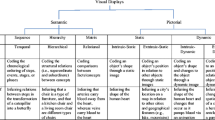Abstract
Computer graphics programs can be regarded as producing a kind of “externalized mental imagery.” These programs are constructed to perform as aids to visualization, allowing one to observe the results of visualizing and transforming patterns. To the extent that the programs circumvent the resolution and capacity limitations of the human visual imagery system, they are a definite advance over visualizing in one’s head. That is, natural visualization is limited by how sharp a person’s mental images are and by how much material can be maintained or transformed at once in an image. Computer graphics programs in principle need have no such limitations. However, to the extent that graphics programs are “unnatural” or incapable of mimicking human imagery transformations, they will be more difficult to learn and use. This paper compares and contrasts human imagery with several graphics programs on more than 30 dimensions, with a twofold purpose: to explore ways in which graphics programs could be improved to better externalize mental imagery and to discover ways in which human imagery might be enhanced by utilizing ideas from computer graphics.
Access this chapter
Tax calculation will be finalised at checkout
Purchases are for personal use only
Preview
Unable to display preview. Download preview PDF.
Similar content being viewed by others
References
Apple Computer, MacPaint, Apple Computer, Inc. Cupertino, California, 1983.
Apple Computer, MacDraw [includes undated supplement], Apple Computer, Inc. Cupertino, California, 1984.
C. Bundeson, and A. Larsen, Visual transformation of size, J. Exp. Psychol. Human Perception Performance 1, 214–220 (1975).
B. Edwards, Drawing on the Right Side of the Brain, J. P. TARCHER, LOS Angeles, 1979.
R. Finke, and S. M. Kosslyn, Mental imagery acuity in the peripheral visual field, J. Exp. Psychol. Human Perception Performance 6, 126–139 (1980).
V. Guzelimian, Becoming a MacArtist, Compute Publications, Greensboro, North Carolina, 1985.
S. M. Kosslyn, Information representation in visual images, Cognitive Psychol. 7, 141–370 (1975).
S. M. Kosslyn, Measuring the visual angle of the mind’s eye, Cognitive Psychol. 10, 356–389 (1978).
S. M. Kosslyn, Image and Mind, Harvard University Press, Cambridge, Massachusetts, 1980.
S. M. Kosslyn, T. M. Ball, and B.J. Reiser, Visual images preserve metric spatial information: Evidence from studies of image scanning, J. Exp. Psychol. Human Perception Performance 4, 47–60 (1978).
S. M. Kosslyn, J. L. Brunn, K. B. Cave, and R. W. Wallach, Individual differences in visual imagery: A computational analysis, Cognition 18, 195–243 (1984).
S. M. Kosslyn, C. B. Cave and D. Provost, Sequential processes in image generation: An objective measure (submitted).
S. M. Kosslyn, B.J. Reiser, M.J. Farah, and S. L. Fliegel, Generating visual images: Units and relations, J. Exp. Psychol. General 112, 278–303 (1983).
G. Ratcliff, Disturbances of spatial orientation associated with cerebral lesions, in Spatial Abilities: Developmental and Psysiological Foundations, M. Potegal, Ed., Academic, New York, 1982.
R. N. Shepard, and J. Metzler, Mental rotation of three-dimensional objects, Science 171, 701–703 (1971).
J. K. Stevens, Reverse engineering the brain, Byte 10, (4), 286–299 (1985).
R. J. Weber and J. Castleman, The time it takes to imagine, Perception Psychophys. 8, 165–168.
R.J. Weber, and R. Harnish, Visual imagery for words: The Hebb test, J. Exp. Psychol. 102. 409–414 (1974).
R.J. Weber, and F. V. Malmstrom, Measuring the size of mental images, J. Exp. Psychol. Human Perception Performance 5, 1–12 (1979). 324
R. J. Weber, L. Hochhaus, and W. D. Brown, Equivalence of perceptual and imaginal representation: Developmental changes, Attention and Performance IX, J. Long and A. Baddeley, eds., L. Erlbaum Assoc., Hillsdale, N.J., 1981.
Author information
Authors and Affiliations
Editor information
Editors and Affiliations
Rights and permissions
Copyright information
© 1986 Plenum Press, New York
About this chapter
Cite this chapter
Weber, R.J., Kosslyn, S.M. (1986). Computer Graphics and Mental Imagery. In: Chang, SK., Ichikawa, T., Ligomenides, P.A. (eds) Visual Languages. Management and Information Systems. Springer, Boston, MA. https://doi.org/10.1007/978-1-4613-1805-7_13
Download citation
DOI: https://doi.org/10.1007/978-1-4613-1805-7_13
Publisher Name: Springer, Boston, MA
Print ISBN: 978-1-4612-9010-0
Online ISBN: 978-1-4613-1805-7
eBook Packages: Springer Book Archive




